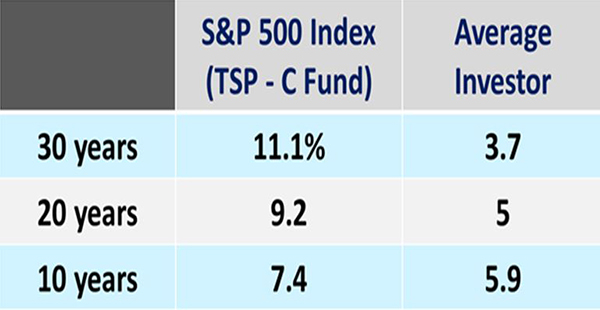I don’t think the media do us any favors in the investment arena. More often than not, what I read, watch or hear does us more harm than good.
It’s not just what’s said. It’s the subliminal misguided perceptions about investing planted in our minds when faced with the following situations.
- The constant reporting of how the investment markets did at the end of every workday. The DOW is up; the DOW is down and how it implies a winner or a loser.
- Viewing the business news channels that follow the markets throughout the day and report on specific companies’ stock values.
- Viewing the shows with stock pickers telling you to buy or dump various stocks based on their predictions.
- The ratings of top mutual funds, stocks, bonds, etc, etc., in magazines and newspapers.
- All the articles touting “…you must own these investments…” to be wealthy or retire comfortably.
- The reports connecting negative national and world events to the markets and our investments.
- Do this one month and do this the next month. And all the conflicting advice.
Too many of us are left with the impression that being a successful investor requires:
- Daily or regular involvement.
- Constant change.
- Playing the stock market by timing the markets and your investment selections.
- Moving your investments around among the funds in your 401k/TSP/IRAs.
- Picking funds based on those with the best reported returns.
- Specialized education or training.
- A get-rich-quick scheme.
- Listening to Uncle Joe for investment advice.
- Too much effort.
Some believe the deck is stacked against us so why try.
We know average investors aren’t successful because data collected from investment accounts indicate individuals tend to have average annual returns well below the free-flowing markets.
According to the data collection and analysis firm DALBAR from a 2014 report, look how the average investor did against the free-flowing S&P 500 stock index.

What does this mean in dollars? Starting with $10,000, over the 30 year period, the S&P 500 index would have grown to $235,190 while the average investor compiled $29,740.
At this rate, people won’t have enough wealth to retire and more people will rely on the government for retirement security at a time when the government is broke. Congress is already talking about whether the government should take over our retirement investments since we can’t be trusted to do the right thing for ourselves.
How did the average investor fall so far behind? Partly because we are never taught how to be successful investors and, if we try to learn, look at the information we get from the media—“Buy These Funds NOW!” And in the financial service arena, you can’t tell the sales people from the honest advisers who work for your benefit.
So where do we go from here? First realize that successful investing is boring and that’s why we don’t get realistic, quality information from media. If the media explained the real story, it wouldn’t catch our attention, it wouldn’t sell media and there wouldn’t be anything else to write about.
We shouldn’t look for excitement or expect to read about success in 140 characters. Being a successful investor requires a little time to understand a few key concepts but none of the concepts are cosmic. Anyone can be successful with a little knowledge and a lot of discipline. If you are doing it right, your days should be calm and your nights restful. Remember, it’s boring.
So here are the lessons successful investors live by.
1) Learn to appreciate saving and investing more than spending. Spending is a short-term high. Assets from savings and investments are a deep and lasting satisfaction.
2) Realize wealth is about what you’re worth not what you earn. Wealth provides freedom. Otherwise you’ll be a slave to a paycheck your whole life.
“Man! If I made $150,000 a year, I’d be rich!” Wrong. There are plenty of people who make lots of money but have low-net-worth. Ask any low-net-worth professional athlete what happened when the paychecks stopped. There are high-net-worth people who earn average incomes. 80% of millionaires in the U.S. are average citizens who budgeted and invested well over their careers (“The Millionaire Next Door” by Thomas J. Stanley).
3) Know the difference between an asset and a liability. Assets increase in value over time and you own them. Liabilities decrease in value and don’t last. To build wealth, increase your assets and decrease your liabilities.
4) Learn the difference between good credit and bad credit. Good credit, like a mortgage or an education loan, can help you build assets. Bad credit, like consumer credit, makes buying disposable or short-lived products more expensive. You end up with nothing to show for your money. However, all debt can be bad if not maintained at reasonable levels for your income. The ideal is to have minimal debt to no debt.
5) You don’t have to take high risks or have a get-rich-quick scheme. In fact, stay away from these. Don’t listen to any marketing or sales pitches. These only make the sellers rich. Most times, if a person approaches me about playing with penny stocks or stock options or the lottery or gambling or sweepstakes or multi-level-marketing programs, the person is usually the last person on the earth who should be messing with these programs. It seems there is a correlation between not having any assets and the need to find a get-rich-quick scheme. Sales people know this and take advantage of this investor psychology. So…
6) Slow and steady wins the race. It’s a marathon; not a sprint. It’s like building a home. Start with a solid foundation; emergency savings, a good budget, spending less than you make. Build solidly planned investments in real asset building funds within your 401k/TSP/IRAs. When you’ve built your home (so to speak) and can afford to throw money away, then you can play with the stuff in point 5 above. I have no idea why you would want to though.
7) Get rid of emotional investing. If emotion drives your investment strategy, you lose every time. Emotional investments are based on pushing your greed or fear button. Gold is an investment that is routinely sold by appealing to your greed or fear. Listen carefully to ads and sales pitches to determine which button they are pushing on you.
8) Carve out a portion of your paycheck off the top to invest in your 401k/TSP/IRA every pay period. Live off the remainder of your pay. Credit isn’t a source of living income. If you wait to invest after you’ve paid bills and lived, you’ll never have investments/assets. “A part of all you earn is yours to keep.” (from The Richest Man in Babylon)
9) Wealth is about ownership. Why are wealthy people wealthy? They have lots of ownership in companies, properties, or their own businesses–assets not liabilities. The stock funds in your 401k/TSP/IRAs and other investment accounts represent ownership in companies world-wide. It’s the number of shares (ownership) in your account that determines your wealth. The account value will rise over time as a by-product of your ownership level. Focus on the collection of shares. The person who retires with the most shares wins. Search “averaging down” on this site to learn more about building ownership in your accounts.
10) As your income rises, so should your contributions to your investments. Not just the raw number increases but the percentage of your income going into assets should increase over time. Besides your money investments, invest in your career-self to increase your career value and marketability. Your lifetime income is part of your worth. Make more income to increase your net-worth; not to have more worthless toys. The new car smell wears off however increased wealth provides you options like earlier retirement or the ability to work because you want to and not because you have to.
11) Learn how to build a portfolio allocation to meet long-range objectives and to get out of self-defeating activities like market-timing and churning your individual investments. This Financial Frontlines site is full of lessons on building appropriate portfolio allocations (search “portfolio allocation”). The investment pros can’t regularly beat the free-flowing markets with all their staff, research and trading strategies. What makes us think we can? NOTE: we don’t need to beat the markets. We don’t have to beat the markets to do well. See the table above. Just understand portfolio allocations.
I know people who followed these lessons early in their careers and are now 50-year-old millionaires. Ordinary, average wage earning people. Be patient. The key to success is learning to not listen to news, media, sales people and friends/family. Building wealth doesn’t “trend.” It’s not a fad, new technique or a hot tip. Wealth is the result of proven timeless concepts and strategies implemented over your career.
If you want to read something that can help, read “The Richest Man in Babylon” by George S. Clason. This old book has timeless lessons that will serve you well.
Join MOAA Today
Not a member of MOAA? Premium and Life members can consult our financial staff for education and consumer advice.
Already a MOAA member? MOAA has hundreds of chapters around the country. Get involved in your community by finding the one closest to you and joining today!

